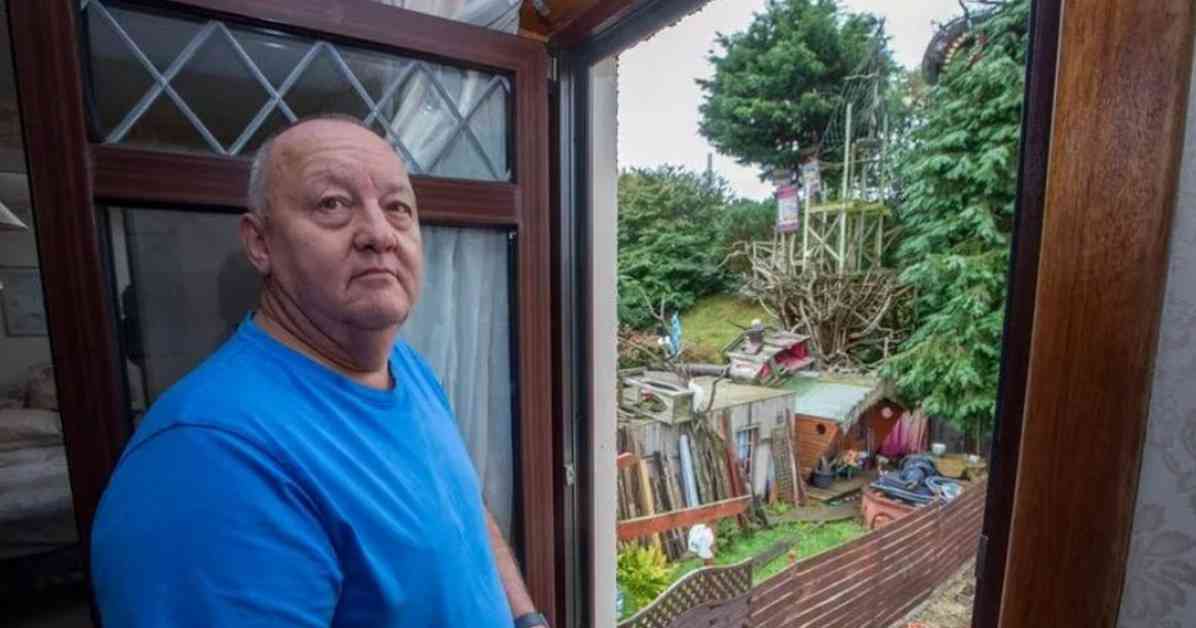**Challenges Selling Scottish Home for Care Fees Due to Eyesore Neighbors**
John Kirby is facing a challenging situation as he attempts to sell his mother’s Scottish home to cover her care fees. The obstacle? An “eyesore” created by his neighbor, artist Denis Carbonaro. Potential buyers have been deterred by Denis’s latest work of sculpture, which John describes as nothing more than “fly-tipping.” This dilemma has left John in a difficult position, as he urgently needs to sell the property to finance his mother’s care costs.
**The Artistic Dispute Next Door**
Denis Carbonaro gained attention previously for his attempts to establish a “sculpture park” in his front and back garden. His artistic endeavors included constructing a woolly mammoth, a Spanish galleon up a tree, a giant spider, and a shrine during the Covid-19 pandemic. However, it is Denis’s latest installations that have caused controversy, with John and other neighbors expressing dismay at the clutter and disarray in Denis’s garden.
John, aged 61, acknowledges that he initially admired Denis’s earlier works of art. However, he now contends that Denis has transformed his garden into a dumping ground for various items, including shopping trolleys and prams, all under the guise of “modern art.” This shift in Denis’s artistic approach has not only garnered negative reactions from the public but has also had severe repercussions for John and his family’s attempts to sell their property.
**Impact on the Sale of John’s Mother’s Home**
John’s mother, who was diagnosed with Alzheimer’s in 2021 and currently resides in a care home, requires the proceeds from the sale of her home to cover her ongoing care expenses. Despite the property being on the market for several months at just under £160k, potential buyers have been deterred by the unsightly display next door. Each prospective buyer who has viewed the house has expressed admiration for the property itself but has ultimately been dissuaded by the eyesore created by Denis’s garden.
The situation has left John feeling frustrated and helpless, as he grapples with the challenge of selling the house amidst the ongoing artistic dispute. He has made efforts to address the issue with the council, only to be informed that Denis is within his rights to display whatever he chooses in his front garden. This lack of recourse has exacerbated the situation, leaving John at a loss for solutions to resolve the impasse.
**Denis’s Response and Artistic Intent**
In response to the allegations and criticisms levied against him, Denis has defended his artistic choices and the symbolic significance of his installations. He asserts that the clutter and items in his garden are not mere refuse but rather intentional representations in his “artivist campaign.” Denis emphasizes that his work at The Bark Park serves as a protest against the exploitation of his privacy and intellectual property rights by visitors who fail to support his creations.
While acknowledging the concerns raised by John and other neighbors, Denis underscores the complexity of the situation and the multifaceted nature of his artistic expression. He highlights the lack of financial support from visitors despite their admiration for his works and the installations at The Bark Park. Denis contends that the clutter and items in his garden hold meaning and serve as a creative statement against the disregard he has experienced from those who enjoy his art without offering tangible support.
**Seeking Resolution and Moving Forward**
John’s efforts to address the issue with Denis have thus far been met with resistance, leaving him uncertain about the path forward. The ongoing dispute over the artistic installations next door has created a rift in the neighborhood and hindered John’s ability to sell his mother’s home. Despite the challenges and frustrations he faces, John remains determined to find a resolution that will allow him to sell the property and secure the necessary funds for his mother’s care.
As the situation unfolds, it is clear that the clash between artistic expression and property values has significant implications for all parties involved. Finding a balance between artistic freedom and community standards is essential to resolving the conflict and fostering a harmonious neighborhood environment. Ultimately, the resolution of this dispute will require open communication, mutual understanding, and a willingness to seek common ground for the benefit of all involved parties.













